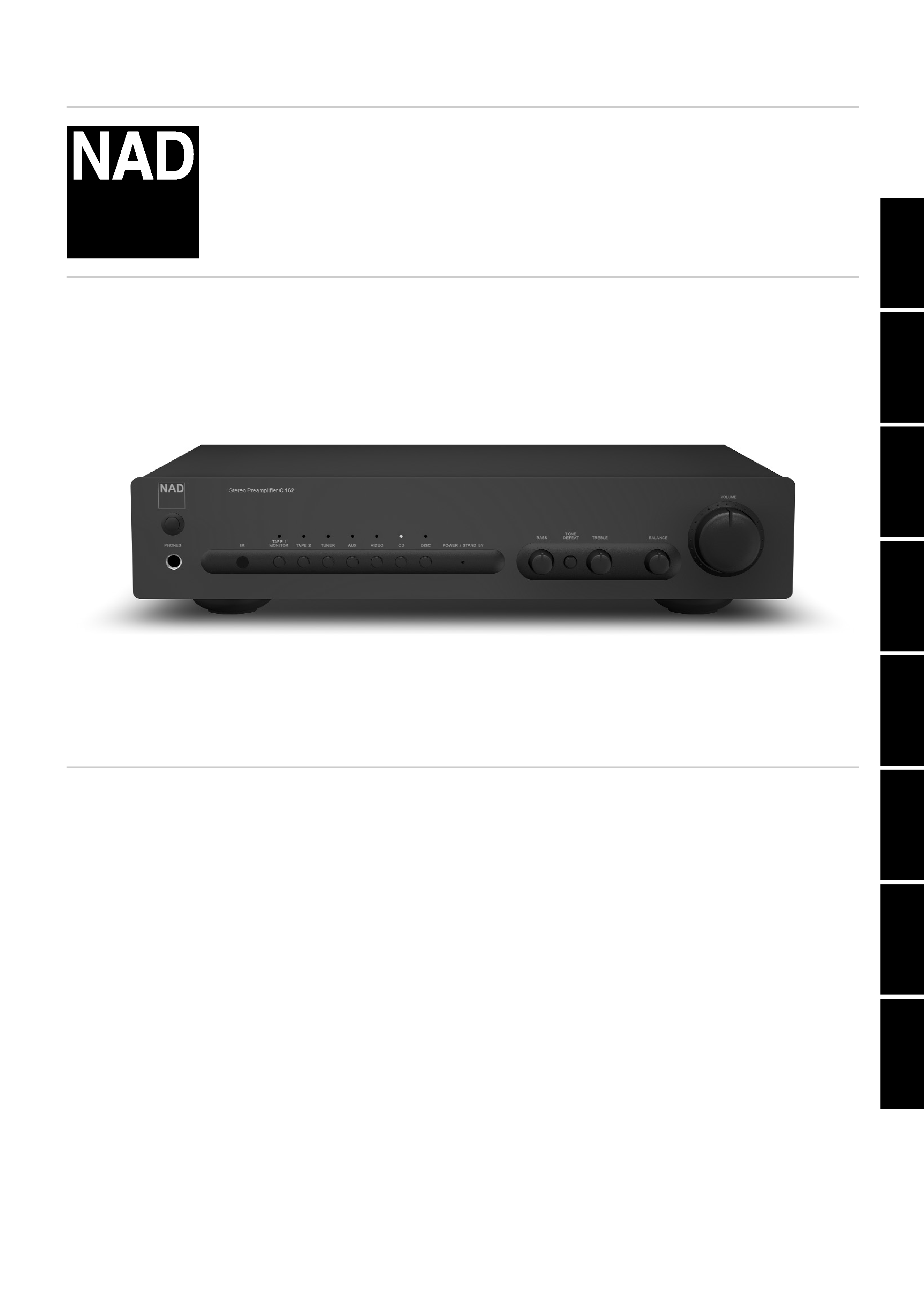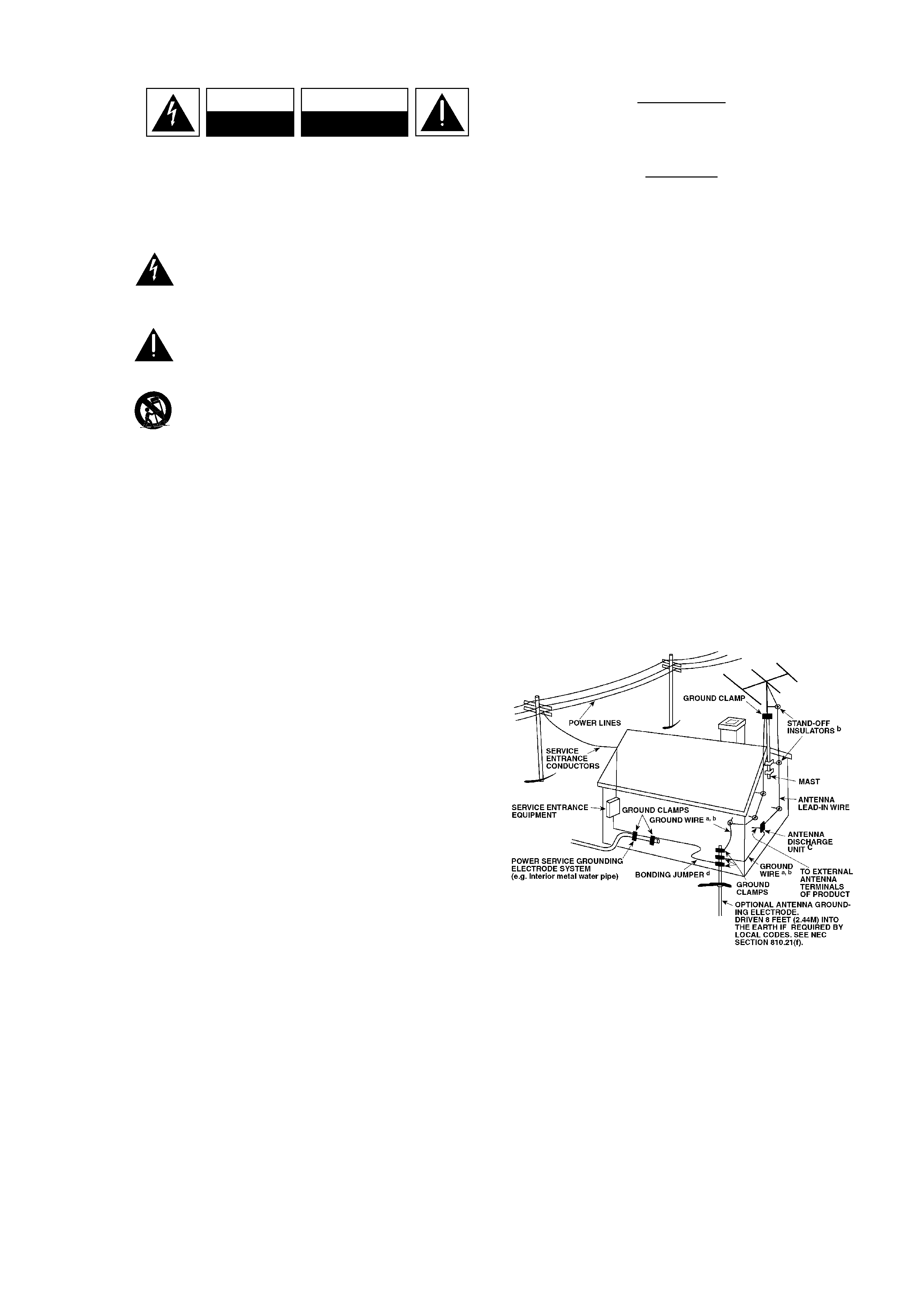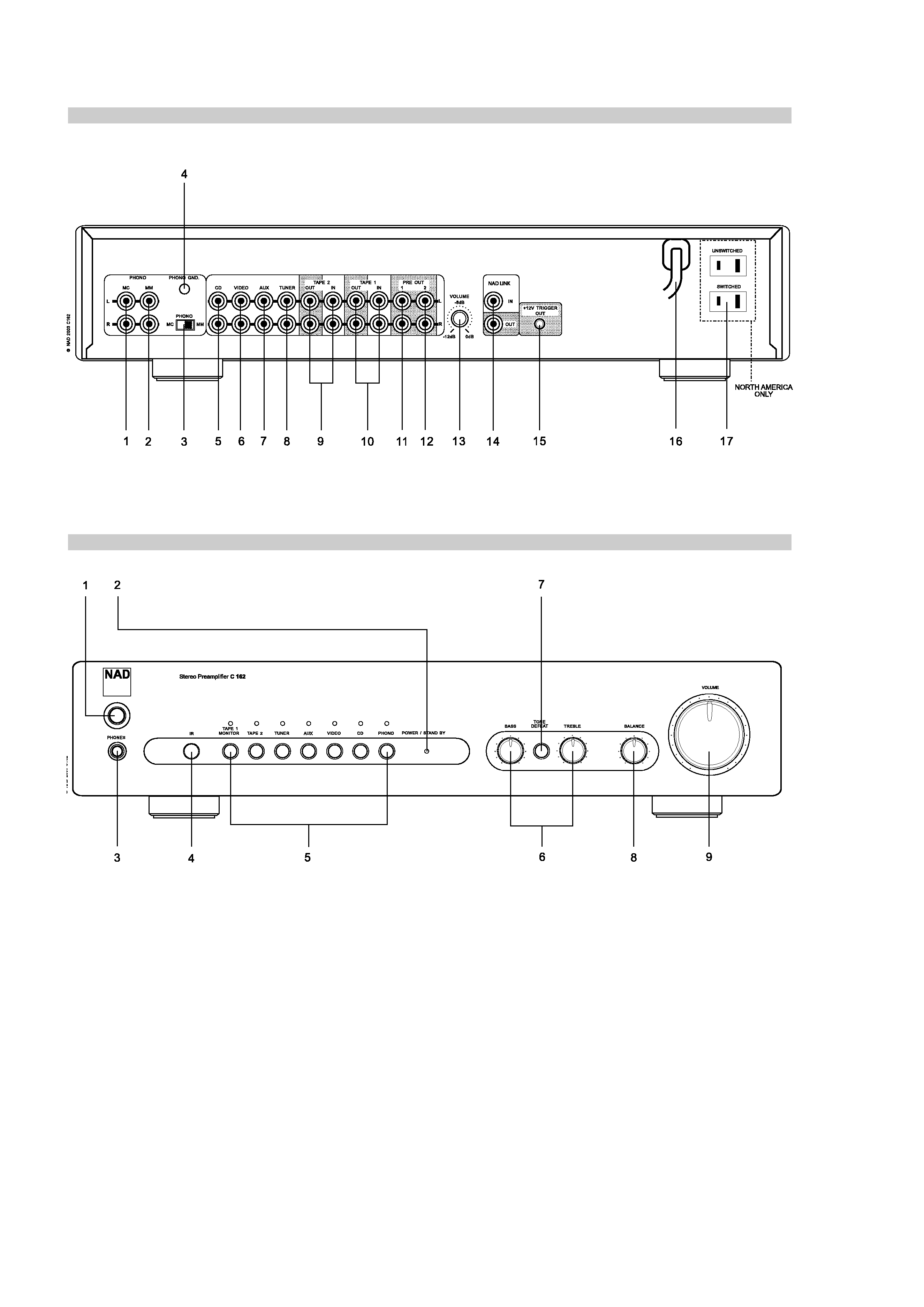
C 162
Stereo Preamplifier
ENGLISH
FRANÇAIS
DEUTSCH
NEDERLANDS
ESP
AÑOL
IT
ALIANO
POR
TUGUÊS
SVENSKA
Owner's Manual
Manuel d'Installation
Bedienungsanleitung
Gebruikershandleiding
Manual del Usuario
Manuale delle Istruzioni
Manual do Proprietário
Bruksanvisning
®

2
Warning: To reduce the risk of fire or electric shock, do not
expose this unit to rain or moisture.
The lightning flash with an arrowhead symbol within an
equilateral triangle, is intended to alert the user to the
presence of uninsulated "dangerous voltage" within the
product's enclosure that may be of sufficient magnitude to
constitute a risk of electric shock to persons.
The exclamation point within an equilateral triangle is
intended to alert the user to the presence of important
operating and maintenance (servicing) instructions in the
literature accompanying the product.
Do not place this unit on an unstable cart, stand or tripod,
bracket or table. The unit may fall, causing serious injury
to a child or adult and serious damage to the unit. Use
only with a cart, stand, tripod, bracket or table
recommended by the manufacturer or sold with the unit. Any
mounting of the device on a wall or ceiling should follow the
manufacturer's instructions and should use a mounting accessory
recommended by the manufacturer.
An appliance and cart combination should be moved with care.
Quick stops, excessive force and uneven surfaces may cause the
appliance and cart combination to overturn.
Read and follow all the safety and operating instructions before
connecting or using this unit. Retain this notice and the owner's
manual for future reference.
All warnings on the unit and in its operating instructions should be
adhered to.
Do not use this unit near water; for example, near a bath tub,
washbowl, kitchen sink, laundry tub, in a wet basement or near a
swimming pool.
The unit should be installed so that its location or position does not
interfere with its proper ventilation. For example, it should not be
situated on a bed, sofa, rug or similar surface that may block the
ventilation openings; or placed in a built-in installation, such as a
bookcase or cabinet, that may impede the flow of air through its
ventilation openings.
The unit should be situated from heat sources such as radiators,
heat registers, stoves or other devices (including amplifiers) that
produce heat.
The unit should be connected to a power supply outlet only of the
voltage and frequency marked on its rear panel.
The power supply cord should be routed so that it is not likely to be
walked on or pinched, especially near the plug, convenience
receptacles, or where the cord exits from the unit.
Unplug the unit from the wall outlet before cleaning. Never use
benzine, thinner or other solvents for cleaning. Use only a soft
damp cloth.
The power supply cord of the unit should be unplugged from the
wall outlet when it is to be unused for a long period of time.
Care should be taken so that objects do not fall, and liquids are not
spilled into the enclosure through any openings.
This unit should be serviced by qualified service personnel when:
A. The power cord or the plug has been damaged; or
B. Objects have fallen, or liquid has been spilled into the unit; or
C. The unit has been exposed to rain or liquids of any kind; or
D. The unit does not appear to operate normally or exhibits a
marked change in performance; or
E. The device has been dropped or the enclosure damaged.
DO NOT ATTEMPT SERVICING OF THIS UNIT
YOURSELF. REFER SERVICING TO QUALIFIED
SERVICE PERSONNEL
Upon completion of any servicing or repairs, request the service
shop's assurance that only Factory Authorized Replacement Parts
with the same characteristics as the original parts have been used,
and that the routine safety checks have been performed to
guarantee that the equipment is in safe operating condition.
REPLACEMENT WITH UNAUTHORIZED PARTS MAY RESULT IN FIRE,
ELECTRIC SHOCK OR OTHER HAZARDS.
ATTENTION
POUR ÉVITER LES CHOC ELECTRIQUES, INTRODUIRE LA
LAME LA PLUS LARGE DE LA FICHE DANS LA BORNE
CORRESPONDANTE DE LA PRISE ET POUSSER JUSQU'AU
FOND.
CAUTION
TO PREVENT ELECTRIC SHOCK, MATCH WIDE BLADE OF
PLUG TO WIDE SLOT FULLY INSERT.
If an indoor antenna is used (either built into the set or installed
separately), never allow any part of the antenna to touch the metal
parts of other electrical appliances such as a lamp, TV set etc.
CAUTION
POWER LINES
Any outdoor antenna must be located away from all power lines.
OUTDOOR ANTENNA GROUNDING
If an outside antenna is connected to your tuner or tuner-
preamplifier, be sure the antenna system is grounded so as to
provide some protection against voltage surges and built-up static
charges. Article 810 of the National Electrical Code, ANSI/NFPA No.
70-1984, provides information with respect to proper grounding of
the mast and supporting structure, grounding of the lead-in wire to
an antenna discharge unit, size of grounding conductors, location of
antenna discharge unit, connection to grounding electrodes and
requirements for the grounding electrode.
a. Use No. 10 AWG (5.3mm2) copper, No. 8 AWG (8.4mm2)
aluminium, No. 17 AWG (1.0mm2) copper-clad steel or bronze
wire, or larger, as a ground wire.
b. Secure antenna lead-in and ground wires to house with stand-off
insulators spaced from 4-6 feet (1.22 - 1.83 m) apart.
c. Mount antenna discharge unit as close as possible to where lead-
in enters house.
d. Use jumper wire not smaller than No.6 AWG (13.3mm2) copper,
or the equivalent, when a separate antenna-grounding electrode
is used. see NEC Section 810-21 (j).
EXAMPLE OF ANTENNA GROUNDING AS PER NATIONAL ELECTRICAL
CODE INSTRUCTIONS CONTAINED IN ARTICLE 810 - RADIO AND
TELEVISION EQUIPMENT.
NOTE TO CATV SYSTEM INSTALLER: This reminder is
provided to call the CATV system installer's attention to
Article 820-40 of the National Electrical Code that provides
guidelines for proper grounding and, in particular, specifies
that the ground cable ground shall be connected to the
grounding system of the building, as close to the point of
cable entry as practical.
CAUTION
RISK OF ELECTRIC
SHOCK DO NOT OPEN
ATTENTION:
RISQUE DE CHOC ELECTRIQUE
NE PAS OUVRIR
CAUTION: TO REDUCE THE RISK OF ELECTRIC
SHOCK, DO NOT REMOVE COVER (OR BACK). NO
USER SERVICEABLE PARTS INSIDE. REFER SERVICING
TO QUALIFIED SERVICE PERSONNEL.
IMPORTANT SAFETY INSTRUCTIONS

3
REAR PANEL CONNECTIONS
FRONT PANEL CONTROLS

4
NOTES ON INSTALLATION
Your NAD C 162 should be placed on a firm, level surface. Avoid placing
the unit in direct sunlight or near sources of heat and damp. Allow
adequate ventilation. Do not place the unit on a soft surface like a
carpet. Do not place or it in an enclosed position such a bookcase or
cabinet that may impede the air-flow through the ventilation slots.
Make sure the unit and other components of your system are switched
off before making any connections.
The RCA sockets on your NAD C 162 are colour coded for convenience.
Red and white are Right and Left audio respectively, and yellow for NAD
Link.
Use high quality leads and sockets for optimum performance and
reliability. Ensure that leads and sockets are not damaged in any way
and all sockets are firmly pushed home.
If the unit is not going to be used for some time, disconnect the plug
from the AC socket.
Should water get into your NAD C 162, shut off the power to the unit
and remove the plug from the AC socket. Have the unit inspected by a
qualified service technician before attempting to use it again.
Do not remove the cover, there are no user-serviceable parts inside.
Use a dry soft cloth to clean the unit. If necessary, lightly dampen the
cloth with soapy water. Do not use solutions containing benzol or other
volatile agents.
REAR PANEL CONNECTIONS
1. MC INPUT
Input for a Moving Coil phono cartridge. Connect the twin RCA lead
from your turntable to this input if you are using a Moving Coil
cartridge.
2. MM INPUT
Input for a Moving Magnet phono cartridge. Connect the twin RCA
lead from your turntable to this input if you are using a Moving Magnet
cartridge.
3. MC-MM SWITCH
Use this switch to select the phono input you are using.
4. PHONO GROUND CONNECTOR
Often, the twin RCA leads from turntables also includes a single wire
earth lead. Use the NAD C 162 phono ground connector to connect this
lead. Unscrew the terminal to expose the hole, which will accept the
lead. After insertion, tighten the terminal to secure the lead.
5. CD INPUT
Input for a CD or other line-level signal source. Use a twin RCA-to-RCA
lead to connect the CD player's left and right `Audio Outputs' to this
input. The NAD C 162 only accepts analogue signals from your CD
player.
6. VIDEO INPUT
Input for the audio signal from a stereo VCR (or stereo TV/Satellite/Cable
receiver) or other line-level audio source. Using twin RCA-to-RCA leads,
connect to the left and right `Audio Out' of the unit to these inputs.
Note: These are audio inputs only.
7. AUX INPUT
Input for additional line level input signals such as another CD player.
Use a twin RCA-to-RCA lead to connect the auxiliary unit's left and right
`Audio Outputs' to this input.
8. TUNER INPUT
Input for a Tuner or other line-level signal source. Use a twin RCA-to-
RCA lead to connect the Tuner left and right `Audio Outputs' to this
input.
9. TAPE 2 IN, OUT
Connections for analogue recording and playback to an audio tape
recorder of any type. Using twin RCA-to-RCA leads, connect to the left
and right `Audio Output' of the tape machine to the TAPE 2 IN sockets
for playback and tape monitoring. Connect the left and right `Audio
Input' of the tape machine to the TAPE 2 OUT sockets for recording.
10. TAPE 1 IN, OUT
Connections for analogue recording and playback to a secondary audio
tape recorder of any type. Using twin RCA-to-RCA leads, connect to the
left and right `Audio Output' of the tape machine to the TAPE 1 IN
sockets for playback and tape monitoring. Connect the left and right
`Audio Input' of the tape machine to the TAPE 1OUT sockets for
recording.
11. PRE OUT 1
The NAD C 162 allows for the connection multiple power amplifiers. If
you are using a single stereo power amplifier, use the PRE OUT 1
sockets.
If you are using a pair of power amplifiers specifically for Bi-amping, use
the sockets to connect the power amplifier with the lowest gain of the
pair. Refer also to chapter "Bi-amping" for more information.
Use a twin RCA-to-RCA lead to connect to the left and right `Audio
Input' of the Power amp to the PRE OUT 1 sockets.
12. PRE OUT 2
The PRE OUT 2 sockets can be used to drive an additional power
amplifier. The VOLUME PRE OUT 2 control (13) can be used to reduce
the output level of the pre-amplifier to the power amplifier by up to -
12dB. With the VOLUME PRE OUT 2 control set to the maximum
position (at the 0dB position), the output level will be identical to that of
the PRE OUT 1 sockets.
If you are using a pair of power amplifiers specifically for Bi-amping, use
the PRE OUT 2 sockets to connect the power amplifier with the highest
gain of the pair. By adjusting the VOLUME PRE OUT 2 control (13) the
volume level can be matched exactly to that of the power amplfier
connected to the PRE OUT 1 sockets. Refer also to chapter "Bi-amping"
for more information.
Use a twin RCA-to-RCA lead to connect to the left and right `Audio
Input' of the Power amp to the PRE OUT 1 sockets.
13. VOLUME PRE OUT 2
The VOLUME Pre Out 2 control allows for adjustment of the output level
of the PRE OUT 2 sockets. The output level can be reduced by up to
12dB; when set to the maximum position (at the 0dB position), the
output level will be identical to that of the PRE OUT 1 sockets. Refer also
to chapter "Bi-amping" for more information.
NOTE
Always turn the pre-amplifier and associated power amplifiers off
before connecting or disconnecting anything to the Pre-Out 1 & 2
sockets.
ENGLISH
FRANÇAIS
DEUTSCH
NEDERLANDS
ESP
AÑOL
IT
ALIANO
POR
TUGUÊS
SVENSKA

5
ENGLISH
FRANÇAIS
DEUTSCH
NEDERLANDS
ESP
AÑOL
IT
ALIANO
POR
TUGUÊS
SVENSKA
14. NAD LINK IN, OUT
The NAD-Link connector is used to pass commands from other units
fitted with NAD-Link connectors. This allows centralised control of a
complete system, and also allows some of the basic functions of other
NAD components (such as a CD player or cassette-deck) also equipped
with NAD-Link to be controlled with the pre-amplifier's remote control.
To function with such other units, connect the C 162's NAD-Link Out to
the NAD-Link In on the other unit. NAD-Link connectors can be daisy-
chained, IN to OUT, so that a whole system can be controlled from the
remote control facilities of one unit.
15. 12V TRIGGER OUT
The 12V trigger is activated automatically when switching the NAD
C 162 from off or stand-by to on. Connect the 12V trigger to a power
amplifier or AC outlet power strip equipped with a 12V trigger input for
remote on/off switching of those devices. Use a cable terminated with
a 3.5mm Mini-Jack connector at the pre-amplifier's end for connection.
16. AC LINE CORD
Plug the AC power cord into a live AC wall socket. Make sure all
connections have been made before connecting to mains.
17. SWITCHED AND UNSWITCHED POWER OUTLETS
(AH VERSION ONLY)
The AC power cords of other stereo components, such as a CD player,
may be plugged into these accessory outlets. Components plugged into
the outlet marked "switched" will be switched on and off as the pre-
amplifier is switched from stand-by or off to on and vice versa.
Mains power is always available on the outlet marked "unswitched" as
long as the NAD C 162's power cord is plugged into a live AC wall
outlet. This outlet can be used for components which may require
continuous supply of AC mains; some tuners require uninterrupted
mains supply to retain preset memory, for instance.
NOTE
The total power consumption of any components connected to the
AC outlets may not exceed 100 Watts. Never connect the mains
lead of a power amplifier to either the Switched or Unswitched
outlets of the NAD C 162.
QUICK START
1 Connect a twin RCA lead to a power amplifier.
2 Connect the desired sources to the relevant input sockets on the
rear.
3 Connect speakers to the power amplifier.
4 Plug in the AC power cord.
5 Press the POWER button to turn on the NAD C 162.
6 Switch on the power amplifier
7 Press the required input selector.
FRONT PANEL CONTROLS
1. POWER ON/OFF
Press the POWER button to switch the pre-amplifier to its `Stand-by'
mode. The Stand-by indicator (No. 2) over the power button will light
up amber. On the front panel, press any of the input selector buttons to
switch to pre-amplifier on. From the remote control, press the POWER
ON button to switch the unit on. The Stand-by indicator will turn from
amber to green to indicate it is switched on and ready for use.
NOTE
In Stand-by mode the C 162 uses very little power. However, it is
recommended that you switch the unit totally off if it is not going to
be used for more than a couple of days. Switch off completely by
pressing the POWER button on the front panel (No. 1), all lights will
extinguish.
2. POWER/STAND-BY
The indicator LED offers information on the status of the NAD C 162:
Off: The unit is switched off totally.
Amber: The unit is in stand-by mode
Green: The unit is switched on and ready for use.
The LED will also flash when the pre-amplifier receives a remote control
command from the supplied handset.
3. HEADPHONE SOCKET
A 1/4" stereo jack socket is supplied for headphone listening and will
work with conventional headphones of any impedance. Inserting a
headphone jack into this socket automatically switches off the output to
the PRE OUT 1 & 2 sockets on the back panel. The volume, tone and
balance controls are operative for headphone listening. Use a suitable
adapter to connect headphones with other types of sockets, such as
3.5mm stereo `personal stereo' jack plugs.
NOTE
Listening at high levels can damage your hearing.
4. INFRA-RED REMOTE CONTROL COMMAND RECEIVER
The infrared sensor, located behind this circular window, receives
commands from the remote control. There must be a clear line-of-sight
path from the remote control to this window; if that path is obstructed,
the remote control may not work.
